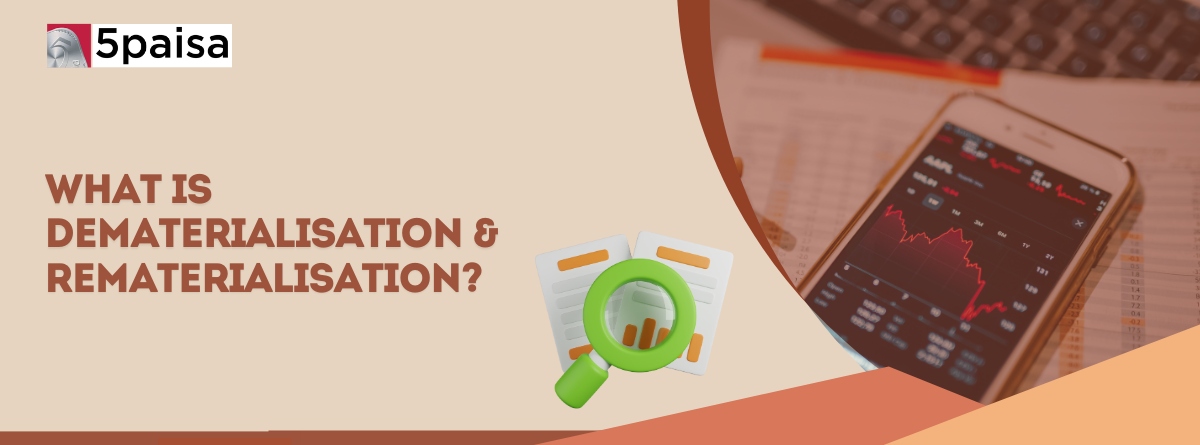Content
What is Dematerialisation?
The Indian stock market has come a long way since its beginnings in 1875 with the "Native Share and Stock Broker's Association," now the Bombay Stock Exchange (BSE). Over the years, technological advancements have transformed how shares are traded.
Earlier, investors had to keep physical share certificates safe from damage or loss, as losing them could lead to financial setbacks. This changed with the Depositories Act, 1996, which required all public companies to issue dematerialized shares.
In this article, we’ll explore dematerialization and rematerialization, their processes, and the differences that every investor should know.
Unlock the full article - sign in with Gmail!
Expand Your Market Knowledge with 5paisa Articles
The Process of Dematerialisation
Dematerialisation is the procedure of converting physical copies of shares and certificates into digital copies. 'Demat' is derived from 'De-' and 'mat’. Here, 'mat' is short for 'materialisation,' which refers to the physical form of securities. This process eliminates the inconvenience of maintaining and handling physical copies of securities.
The process of share dematerialization involves 4 parties; the share issuing company, depository, owner or beneficiary, and depository Participant (DP) or brokerage firm. Here’s what role each participant plays:
- Share Issuing Company: Companies planning to issue dematerialised shares must revise their Articles of Association to accommodate this format and register with a depository.
- Depository: India has two depositories, NSDL and CDSL, which assign a unique 12-digit International Securities Identification Number (ISIN) to each security. Registrars and Transfer Agents facilitate interactions between companies and depositories.
- Investor: Investors must open a 'Demat Account' through depository participants (DPs) or brokerage firms to trade securities like ETFs, stocks, etc. Direct account registration by investors is not allowed.
- Depository Participants (DPs): DPs act as registered agents of depositories, managing Demat account registrations for clients after verifying their documents.
Steps of Dematerialisation
For the conversion of physical shares into electronic form through dematerialisation, you require a Dematerialisation Request Form (DRF). The steps below walk you through the process of dematerialization:
Step 1: With the help of a Depository Participant, open a Demat and Trading account.
Step 2: Submit your physical share certificates along with a completed Dematerialisation Request Form (DRF). Double-check that all required details are accurately filled in before submission.
Step 3: The DP processes your request by forwarding the form and share certificates to the respective depository, transfer agents, and registrars for verification.
Step 4: Once the request is processed, the physical share certificates are destroyed, and the corresponding shares are transferred to the depository.
Step 5: The depository notifies the DP that the dematerialisation process is complete.
Step 6: Finally, the converted shares are credited to your Demat account in electronic form. This process typically takes 15 - 30 days.

Steps of Rematerialization
Similar to the process of share dematerialisation, investors are required to fill a Remat Request Form (RRF) with their respective DP. During the process of rematerialisation, investors cannot trade their shares. The process of rematerialisation is conducted in the following way:
Step 1 - Contact your respective DP so they can provide you with a Remat Request Form (RRF)
Step 2 - After you fill out the RRF, the DP submits it to the depository and share issuer, temporarily blocking your account.
Step 4 - Once the request is processed, the share issuer prints the physical certificates and sends them to you, after confirming with the depository.
Step 5 - Finally, the blocked balance is debited in your account.
Difference Between Dematerialization and Rematerialization
The below gives you a clear picture of the difference between dematerialization and rematerialization:
| |
Dematerialization |
Rematerialization |
| Meaning |
It is the process of converting physical shares into digital form |
It is the process of converting digital shares into physical certificates |
| Execution Process |
Simple steps |
Complex steps and time consuming |
| Objective |
To simplify the trading, transfer, and safekeeping of securities. |
To receive physical share certificates for personal preferences or particular needs. |
Things to Note Before Dematerialisation and Rematerialisation
- According to the new rules and regulations, it is mandatory to conduct all transactions through a registered dematerialisation account.
- Transactions undertaken through registered dematerialisation accounts are faster.
- Rematerialisation of shares shifts the authority of the account to the share issuing company.
- Rematerialised shares do not require a maintenance cost. However, security threats are higher compared to dematerialised shares.
Conclusion
Dematerialisation and rematerialisation are two key processes in the modern stock market that help manage shares more efficiently. While dematerialisation converts physical shares into electronic form, rematerialisation does the reverse. Rematerialization enables investors to hold tangible certificates, while dematerialization streamlines trade, transfer, and storage. In order to manage securities effectively, you must be aware of these procedures and how they differ from one another.




